Today we’re going to talk about one of those topics that bloggers don’t cover much for certain reasons, mainly being that they are not aware of the existence of some monetization and traffic generation options.
If you have been around Stream SEO for a while you’ve probably noticed I talk about different monetization methods besides the typical Google Adsense or Amazon Associates.
That’s because I like to test a ton of things and make money, and I know a ton of people aren’t able to monetize their traffic with those options for various reasons, including being banned from them, or not being approved for whatever reason, or simply because the topic of the website doesn’t necessarily work with the mainstream options.
In this article, we’re going to talk about WEB push notifications and how you can make money from them.
But first, what is a push notification?
I’m glad you asked.
And I’m also pretty sure you have seen them before but maybe you didn’t think they used it as a monetization method. Web push notifications have been getting really popular since the beginning of 2018 or maybe a bit earlier than that.
Here’s how a push notification looks when you go to a website either on your laptop or mobile device:
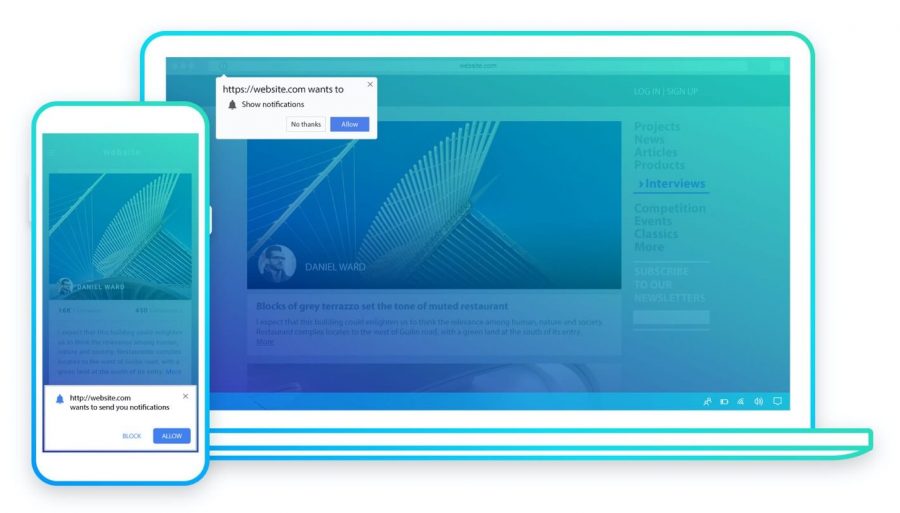
You have seen them before, right?
They can be pretty annoying and a ton of websites have implemented them in the last 2 years. Depending on the website you’re visiting, you either receive:
- Notifications when new posts are published or anything similar
- Notifications of discounts or sales when it’s an eCommerce page
- Ads that sometimes you have no idea how you got in the first place
We are going to focus on point number 3 as that’s how you make money with them. The other 2 options are focused on bringing back repeated traffic to a website but unless you own a news website with tons of content I have noticed most other sites just never send any notifications and when they do, they barely bring back any traffic.
Think about it. In a world where most websites ask you to subscribe via email, Social Media channels, RSS, etc. push notifications are just another way to subscribe yourself and keep updated but it’s one of the worst for several reasons.
Email is much better for sure in terms of quality and people being interested in your website product or content.
Now don’t get me wrong. There are certainly a few websites that are doing it right, but most of them don’t, so it’s just another script and plugin (mostly One signal or competitors) added to your site that does nothing but increasing the load time of your site.
But what if you have a website that for some reason can’t be monetized with Google Adsense?
Or what if your website doesn’t sell any products so you can’t use Amazon either or any of the typical ad networks out there?
Table of Contents
Push notifications to the rescue!
Push notifications can be spammy, for sure, so before you leave a harsh comment below about them let me tell you that I intend this tutorial to work for people who don’t have the typical blog that can be monetized with the mainstream options.
This applies for blogs that have a ton of traffic but for obvious reasons can’t apply to the typical ads such as:
- Streaming websites
- Mp3 and Movie sites
- Dating sites
- Gossip and clickbaity sites where Google or FB consider the content of low quality
- Download sites
- Anything that doesn’t follow Adsense or Amazon rules
- etc.
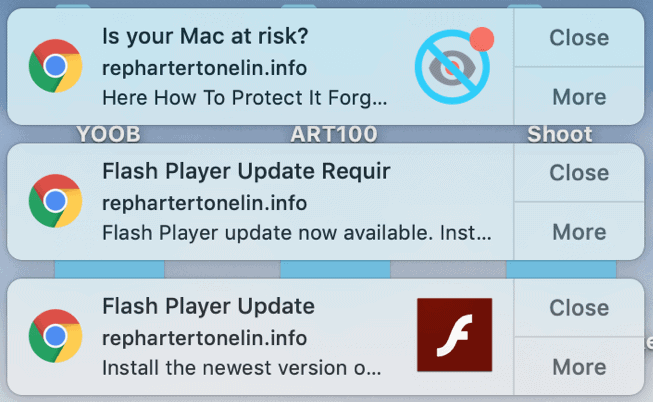
And for those types of sites, we have recommended for years some great alternatives that work with not so conventional ad formats, including but not limited to:
- interstitial ads
- pop-ups and pop-unders
- native ads
- redirects
- etc.
But at the same time, a ton of people was scared of using them lately as Google has been aggressively saying they could penalize sites using those type of ads because of the user experience. So everybody was using them with caution (Native ads are less intrusive though).
And because of that and many other reasons (ad networks being creative to generate more money), web push ads were born.
Obviously, webmasters and affiliates started abusing them, so Google has been doing some changes to tackle the spammy problems with Google Chrome, but so far they still can work quite well if you’ve got enough traffic to feed your subscriber’s database.
In fact, they work great with pretty much any other monetization method you have in your site since they are not intrusive, at least not when the user is surfing your website. And they can be blocked or rejected from the beginning if the user is not interested in getting them.
Here’s a website we have receiving around 1,000 visits per day grabbing push subscribers every time they enter to visit it:
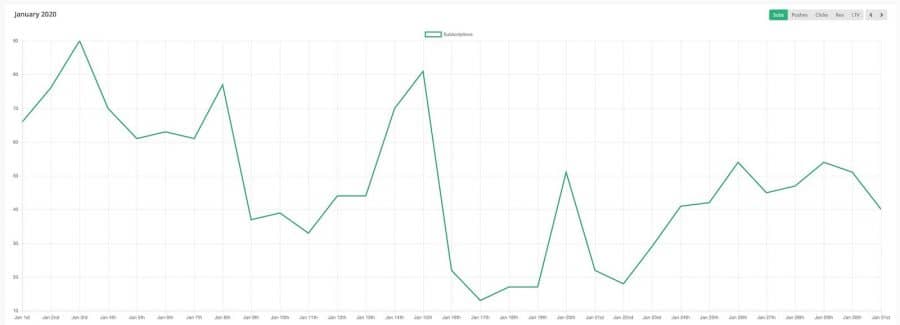
The graph may not be very clear, but we’re gathering around 50 to 90 new push subscribers every day with that amount of traffic, which means the conversion rate is around 5-9%.
Not great, not terrible.
I’ve seen some sites getting just 1% conversion rate and some other sites gathering 15-20% but that’s in the upper side and not that common.
And how do I generate money with those subscribers?
Well, let me show you this graph:
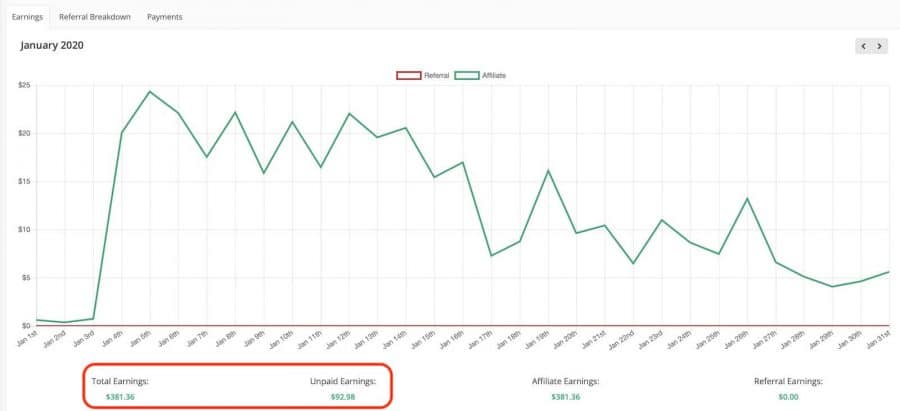
So far the subscribers are generating around $7 to $25 USD per day since we installed the push notifications script (not even a whole month) and while there are some ups and downs, the more subscribers we get, the more it might potentially earn after a few weeks.
For us, that represents close to $400 extra USD per month for a site that was earning around $300 dollar per month with other types of ads.
But as I said, push notifications can be used on top of other ads without hurting user experience so we end up with $300+$400=$700 per month instead of just $400.
This is all organic search traffic, of course, however, there are many ways to get traffic and a ton of people buying traffic from ad networks are using push notifications on top of their typical monetization systems to add some extra revenue from their campaigns.
Here’s a quick view of the top leaders of January:
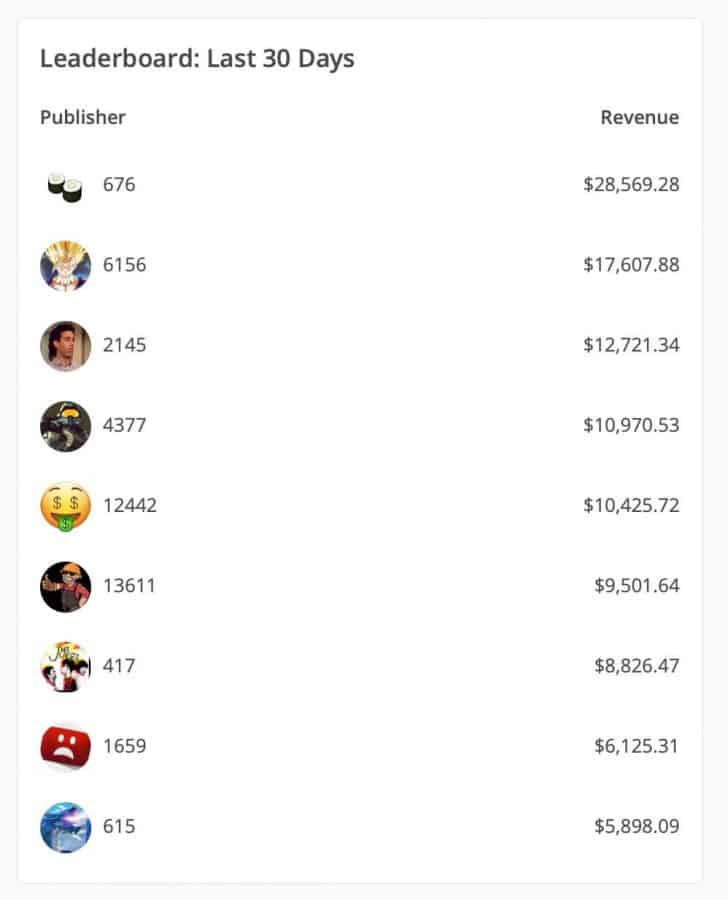
Yeah, you read that right.
The top publisher is generating an extra $28,569 USD per month from their push notifications and while others generate between $5,000 to $15,000 per month, you can see there’s some good revenue potential up there.
The more traffic you get, the better, of course.
Before we get into how you can start making money with push notifications, let me explain to you the pros and cons of using web push ads:
Pros
- High conversion rates
- Easy to implement ad format
- It doesn’t mess up with the user interface of your site
- Monetization is done after the user left your site, and they can be monetized for days, weeks or months to come
- Google so far doesn’t hate them or factor them in terms of SEO, however, they are implementing features to make them less spammy
- The user decides when to stop receiving them
Cons
- They can be very spammy for the user AFTER he left the website. They might not attribute it to you, but still, it’s a spammy
- It doesn’t work on all browsers and OSes. Android has the biggest market share of push notifications as they work on Chrome and other browsers. Desktop traffic has a smaller share but they work for Chrome, Firefox, and Safari but it’s mostly Chrome where you’re going to get subscribers. iOS doesn’t support web push notifications at the moment and it’s obvious Apple doesn’t want to add something like that in their system for now, although they have been saying they want to do it.
As you can see, there are pros and cons, like everything, and you’ve been warned.
Another important thing to notice is push notifications tend to convert really well in tier 3 countries where people use mostly Android phones (think of countries like Egypt, Argentina, Venezuela, Ukraine, etc.). While the CPMs and CPCs are cheaper there, it’s an easy way to generate money from countries where other networks didn’t work for you because of the language barrier and number of advertisers available.
As always, if you have a ton of tier 1 English speaking traffic, you might get better results, but at least you’re not limited to just that.
Meet Monetizer
By now you’re probably asking yourself how can you implement push notifications and where am I getting the screenshots of my subscribers and earnings.
For this tutorial, I’m working with Monetizer. Monetizer is a webmasters network that helps you monetize your traffic by implementing affiliate offers and smart links.
Monetizer is a network I found in 2017-2018 but I didn’t really start using it until the beginning of 2019.
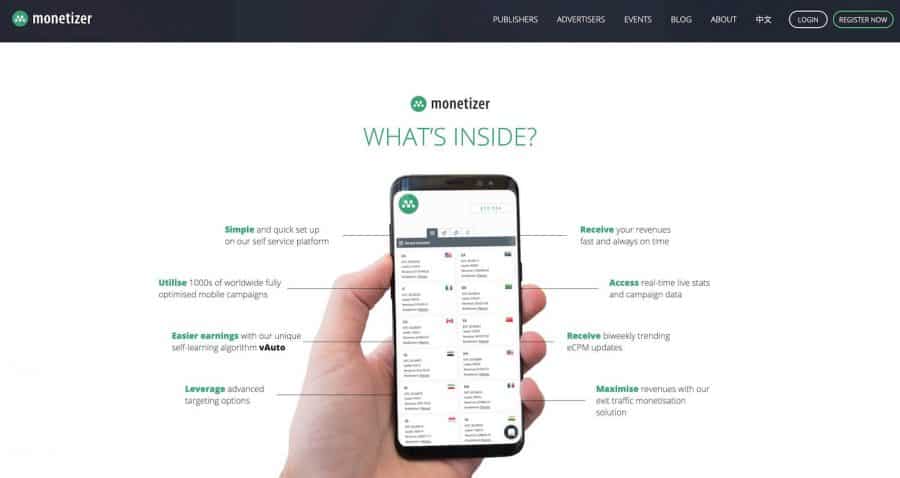
Since last year monetizer added the option to collect push subscribers in your websites by implementing a simple script and after you have done that, the monetization is done by their system which automatically selects the best offers to promote to your subscribed readers.
You just need to sign up as a publisher to get started. Don’t get confused and sign up as an advertiser or else you won’t be able to follow this guide.
Create your Monetizer account!
It takes a few minutes to get started as a publisher.
Once your account is approved and you confirm your email, which should take you 24 hours or so, you will be able to login to your account and see the main dashboard:
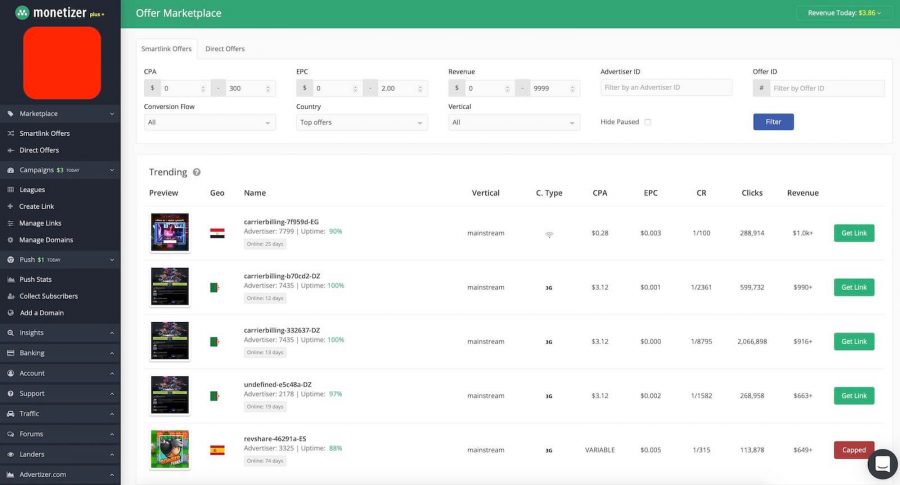
In the dashboard you can see all the offers available and the countries that are performing well on the last day and in the last 7 days, so you can always see what’s working better at the moment as opposed to other networks where there’s no transparency at all.
Ignore the dashboard as we’re not looking to promote affiliate offers directly in this tutorial. What we want to do is to implement the push subscriber’s script in our website so please go to the “add a domain” menu at the left side and you will see this panel:
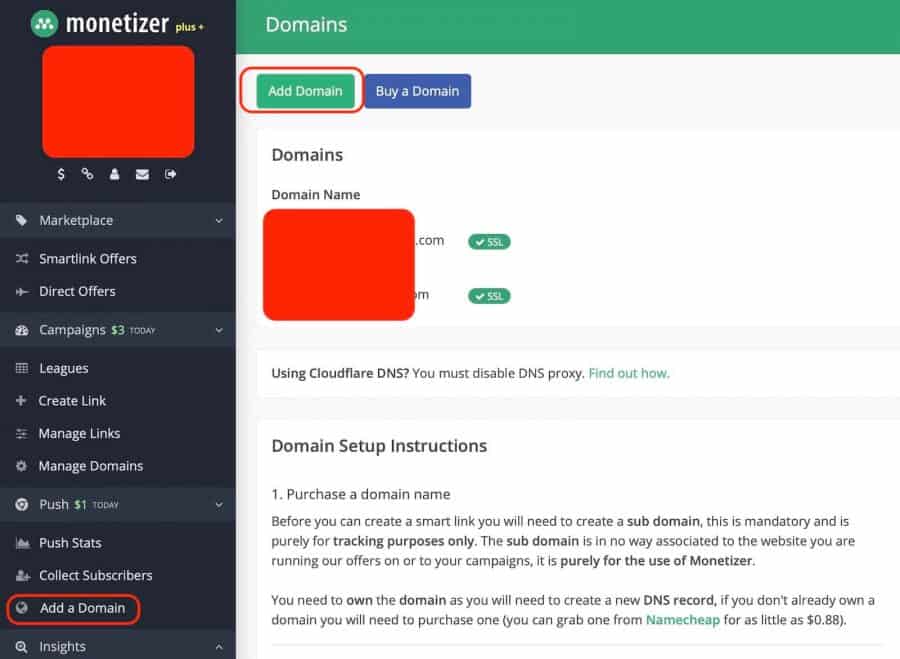
My panel already has 2 domains but yours will be empty. So you need to click the green “add domain” button at the top to add a new domain.
Before you screw anything up, let me explain something. Since Monetizer (the ad network) is implementing the push notifications script for you, you need to get a secondary domain to create your script.
When you host the script yourself using a WordPress plugin you can use your same domain or a subdomain, but in this case, Monetizer handles it for you but you need a second domain to do everything. Some networks offer their own script in their own tracking domains but having them separately actually makes more sense and it’s safer for everybody.
So please go and buy any secondary domain (preferably .com or the same TLD as your current website) from your favorite domain registrar. I prefer using Namecheap as domains are cheap ($10 per year give or take) there and you don’t have to pay for privacy or extra stuff you don’t need.
Once you have a new domain, you can proceed with the tutorial. Now we’re going to add that domain to our Monetizer’s account:
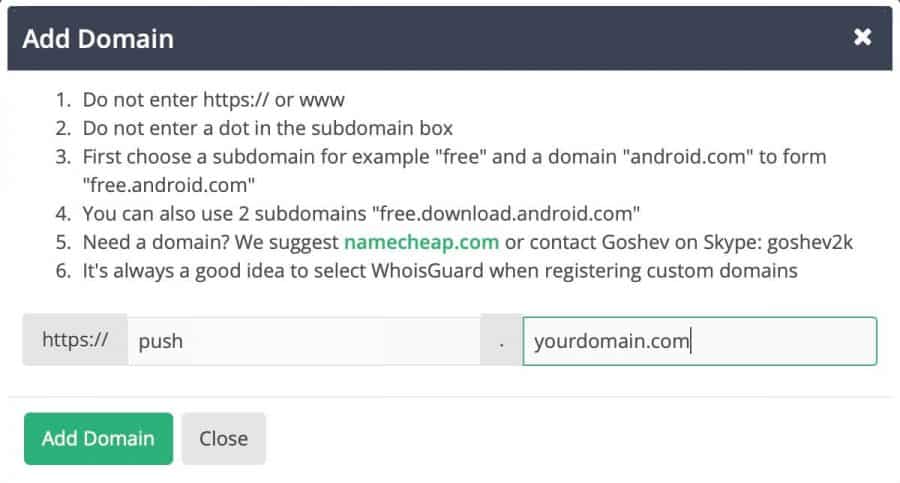
You actually need to define a subdomain in monetizer along with your domain, so if your domain for the push notifications is yourdomain.com, you need to set up a subdomain as I did in the picture above: push.yourdomain.com
After that, hit the “Add domain” button and Monetizer will give you a unique IP for your domain. You need to configure that IP in your domain registrar which is quite simple and takes a few minutes.
Here’s how I did it with Namecheap:
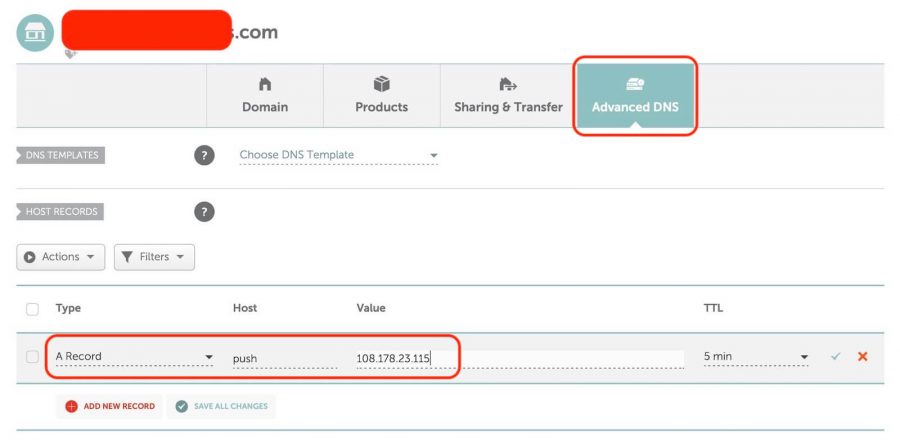
Basically, you just need to set up an A record for your domain and add a host (the subdomain) and the IP and you’re good to go.
Once you do this the domain can be used to promote any offers from monetizer, or in this case, fire up the push notifications. However, you need to wait a few hours for the domain to propagate and for Monetizer to issue an SSL certificate for your domain which can take up to 24 hours (normally it works after 2-6 hours in my experience).
You will notice when your SSL certificate works if you go to your domain’s menu in Monetizer as the domain will change from yellow to green.
And talking about SSL certificates…
Push notifications require a secure connection between your site and your reader’s browser, so you need to have a working SSL certificate working in your original blog/website as well, for it to work with the domain+SSL on Monetizer.
By now pretty much any of the big sites and new blogs have an SSL installed to keep up Google happy as it’s a trend that has been going on for 3-4 years, however, if you’re one of those lazy people who haven’t still updated their site address to an HTTPS (SSL) instead of just HTTP (non-SSL), now it’s the best time to do so.
I won’t cover how to do that here because it requires a complete tutorial and it has been covered to death in many other blogs if you do a quick google search.
Creating your push notification Script
Now that you have an account with Monetizer, a secondary domain, and your SSL certificate ready to go, let’s move to the last part of this tutorial.
Create your Monetizer account!
It takes a few minutes to get started as a publisher.
This part might look a bit long or confusing, but everything happens on the same screen and it’s actually quite straight forward, so please bear with me.
Locate the “Collect Subscribers” option in the left menu and click it. You will see the following screen with 2 options:
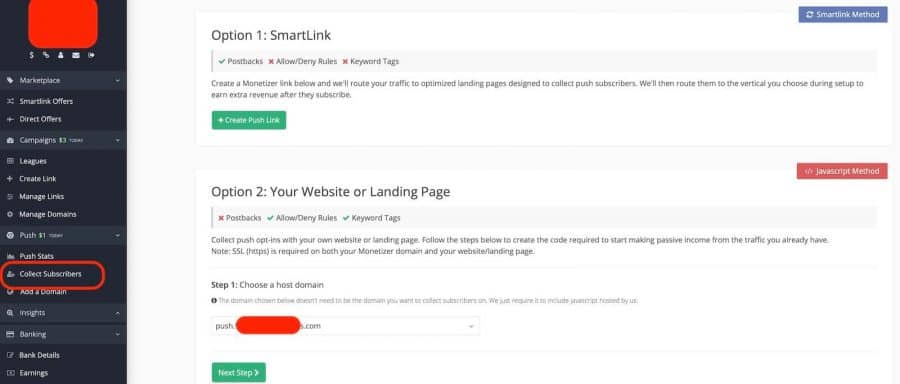
Option one is for people sending traffic straight to a page to collect subscribers, so we will ignore that option and go to option 2.
Option 2 allows you to create your own script and install it on your Website or Landing page to gather subscribers no matter where traffic is coming from.
You will need to select your host domain here, which is the same domain you added to Monetizer before. You shouldn’t have more domains added unless you do it on purpose at the moment.
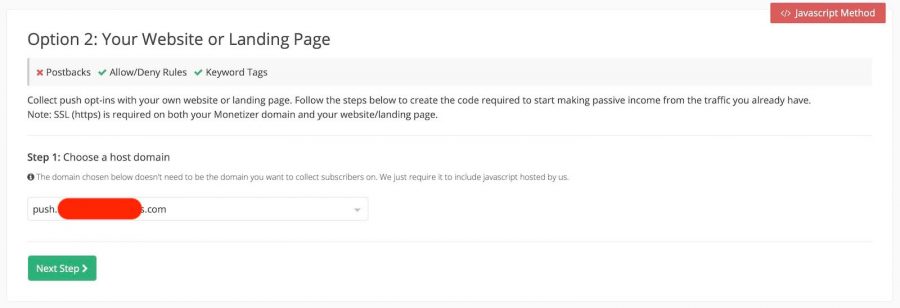
Click “Next step” and now you will be presented with a menu to select if you want to redirect your traffic to a page once they click the allow or deny option once the push notification subscription prompts in their browser.
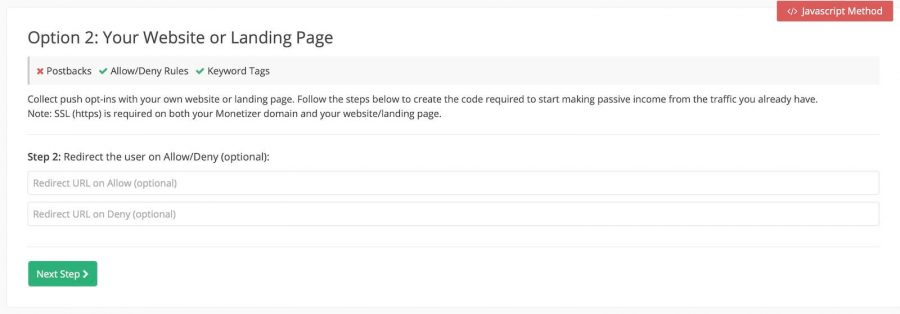
Since your main objective is to gather subscribers but you also want them to keep reading your website after accepting/denying the subscription, you should leave both forms empty as I did above.
If for some reason you really want to redirect your organic users to another page (not recommended for organic traffic) you can do that. Maybe if you have a sales funnel or you want to be creative you could do so, but if you’re only looking to use the push subscribers as an additional monetization method I really recommend leaving this blank.
Click “next step” again and you will be presented with the following option:

In this form, you can enter a tracking tag so when you check your traffic and earning reports at Monetizer you will know from which tags your traffic is coming from.
This could be useful if you can implement different scripts in different pages of your site and you want to see which ones convert more, but I can’t imagine websites with hundreds or thousands of posts doing that, so if that’s your case just write one tag (e.g. name of the website) and you’ll be good to go.
Another reason why you might want to add a tag here is you have many websites where you want to implement this script, you will be able to separate the stats from each other, which can become quite handy in the future.
After that, click “Next step” again. We’re almost done!
Now you will see the option to add an interaction prompt.
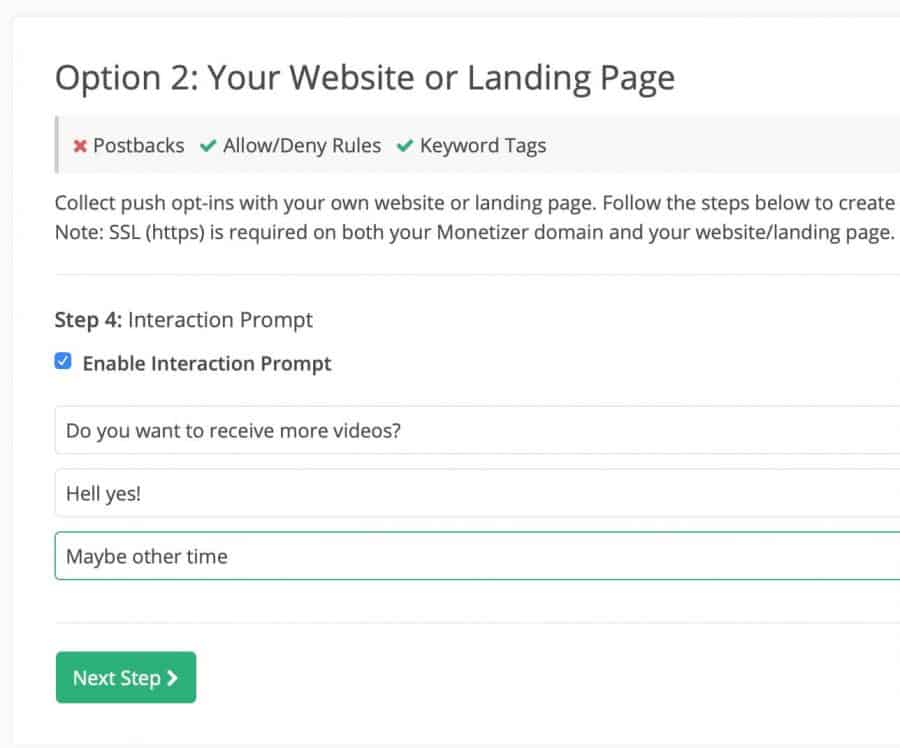
This feature will become handy if your website does something in particular and you want to avoid that generic message everyone shows when collecting subscribers.
For instance, most regular websites collecting push notifications show a prompt in the user’s browser like this:
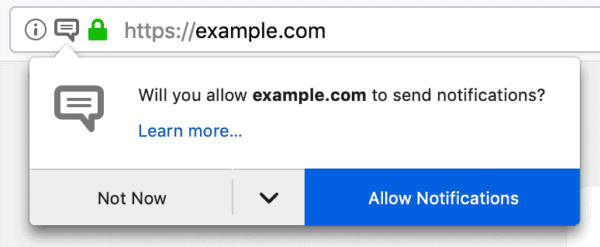
The message is generic and just asks for the people to allow them to receive notifications in the future.
However, if you are a bit creative and you have a specific topic to cover you could increase your conversion rate by modifying that text as I did in the example above.
For example, if your page is about streaming movies, the text could be something like:
Do you want us to notify you when there’s a new movie added to our library?
You get the idea…
Obviously, since you can’t control what is being sent to your subscribers after that the message can be a bit misleading, but since we already said push notifications can be a bit spammy you know the drill and it’s up to you.
If you want to use the generic message most websites use just leave the “Enable interaction prompt” option disabled and click “Next step“.
Now you’ll finally get your script to download and use for your website. Save the script in a local folder and click “next step“.
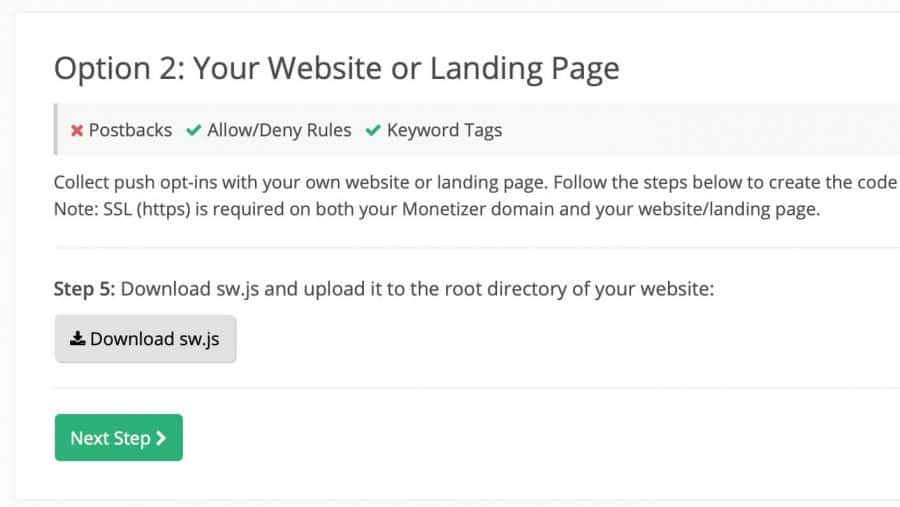
Finally, you will receive a script code that you need to implement in your website for everything to work correctly. Just copy the code and paste it somewhere safe.
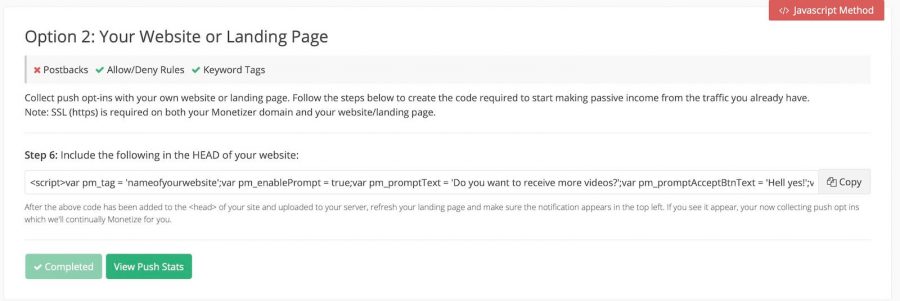
That’s it. You have finalized the set up of your web push notifications in Monetizer and all you need to do now is implement the scripts on your website.
Remember you have 2 scripts. One is the file you downloaded first and the second is just a line of code you need to paste in your website’s header.
Adding the code to the header is easy and it really depends on what platform you’re using to manage your website. If you’re using WordPress there are a ton of plugins that allow you to place codes in the header or footer area of your website in a matter of seconds.
Many WordPress themes also have the option to add scripts already available in their settings, so that’s up to you.
As for the javascript file that you downloaded before, it needs to be uploaded to the root folder of your website’s documents. This can be a bit tricky and it’s hard to explain because it depends on which hosting service you’re using.
Most managed hosts allow you to log in and upload files through their cPanel or WHM administrators. A quick Google search will give you a hundred of methods to implement this.
If you’re not using a managed hosting service I assume you’re at least a bit of an expert and you know how to upload that file via FTP or any other interface you use.
This process is the same people use to upload the famous ads.txt file that Google Adsense requires for every website, so it’s not that difficult and there’s a ton of documentation around. Do your due diligence.
Once the script and code are installed in your site, you will be able to see a push notification like this when visiting your site:

This notification can be ignored, but once you click allow you will start receiving notifications in your browser. Also, if you click Deny or Now now, you won’t be asked again unless you log in with a different browser or device.
That’s why push notifications are easy to handle and aren’t as spammy as those pop-under or interstitial ads that appear every time you visit a website no matter how many times you’ve closed them before.
Please also keep in mind the notifications only work in supported browsers like Chrome and Firefox. If you use an alternative browser you won’t see the prompt and of course, if you visit your site with an iOS device (iPhone/iPad) it won’t work either. That part of your traffic can’t be monetized with push notifications yet.
But for the rest of the people who click the “Allow” button, they will start receiving push notifications every day and every time they click on it or take action you’ll get paid. This revenue will be shown in your Dashboard and will grow over time as subscribers have a lifetime value of a few weeks before wearing off.
The best thing about this is that Monetizer won’t send your subscribers any ads until it’s been an hour since they subscribed. This means those ads won’t interrupt the navigation of your website and other types of monetization that you have implemented already.
1 hour later most users won’t even remember which website they subscribed to and they will just start getting some ads in the form of push notifications in their phones/computes.
Every time they click, you earn a few cents as the network is selling those clicks to advertisers buying that traffic.
Monetizer Payment proof and methods
I’ve been using Monetizer since the beginning of 2019 but I had to set up a new account here to prepare this tutorial. So far I have been paid a few times already for that organic traffic although I have received a ton more payments in my primary account.
Create your Monetizer account!
It takes a few minutes to get started as a publisher.
Here’s a screenshot of the payments from organic traffic in this account since November:
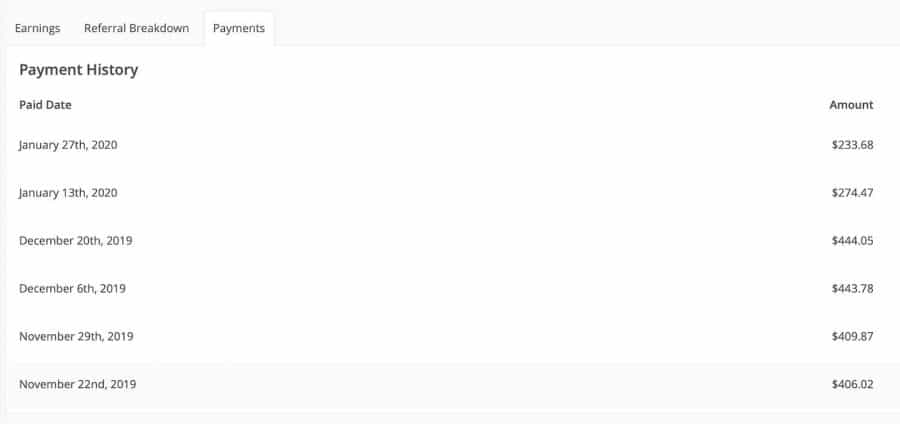
As you can see, not every month has the same performance, but we have already earned a few thousand USD by collecting push subscribers organically.
As for the payment methods, we get the money by PayPal but you can set up wire transfers if you’re earning huge quantities like the top leaders or also select Paxum if that’s what you use instead.
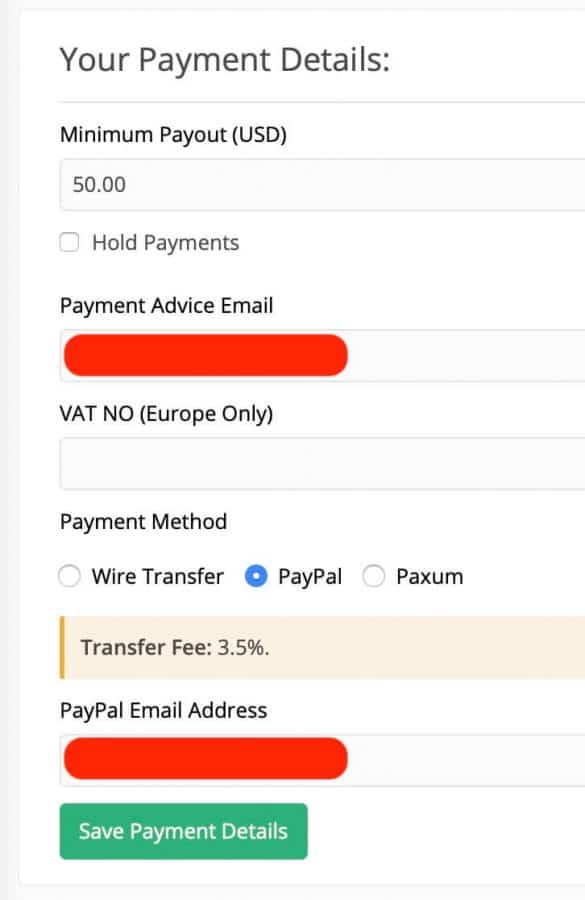
The minimum payout is $50 USD, which is quite decent for a threshold and they can pay you on a weekly basis as long as you earn more than $50. You just need to request your payment at the end of the week right fro your Dashboard.
Automatic payments are done on a weekly basis if you earn more than $250 per week and if you earn more than $5,000 or $10,000 USD (lifetime) you will get even faster payments.
Web Push notifications suck?
In conclusion, I can say any type of ads kind of suck and hurt the user experience of any website at some point. Even the classical banner ads from Google Adsense can be annoying but every website needs to implement a way to make money or they’d be working for free. Just take a look at Forbes!
Push notifications can be a bit intrusive but what’s great so far is that they aren’t intrusive while your traffic is surfing your website. Clicks and impressions happen after the user has left your site (unless they surf by more than 1 hour in the case of Monetizer’s settings) but most sites have an average session duration of just a few minutes.
As you saw at the beginning of this article, Push notifications are just another ad type to help you make money from your traffic, and they can make you a ton of money when used correctly.
In my book, they’re less annoying than interstitial ads or pop-ups/unders. In fact, they are less annoying than some of the mobile floating banners that Google Adsense implements with their auto ads as those reduce the viewing area of a website on mobile devices.
Quick reminder: if you want to create a personal or high-quality blog where you care about the content and readers and you have the option to be approved with one of the big networks, don’t use this method. This method is only recommended when for whatever reason you don’t have access to other monetization methods or simply when you want to add some extra revenue but you don’t care about what happens after the user leaves your site.
There’s a reason why you don’t see push notification ads here at Stream SEO 🙂 but I definitely use them in some of my website’s portfolio.
How will push notifications evolve in the future years? I don’t know, but milk them as much as you can while you can 🙂
P.S. Other networks that offer Web push notifications as part of their inventory that quickly come to my mind are:
- MGID (originally native ads)
- Propeller Ads (originally pop ads and now native and push as well)
- EVADAV (Exclusively push ads but expanding to pops)
- Adsterra (originally pops but expanding to push. Check out our review here)
- Richpush
- AdMaven
- etc.
There are tons of alternatives offering with push notifications nowadays and I can’t mention them all. However, Monetizer is a great network to get started and they’re super transparent about their stats and they are always implementing new options, so I think they’re great for this tutorial (plus they make the most money out of each subscriber in my tests).
Create your Monetizer account!
It takes a few minutes to get started as a publisher.


